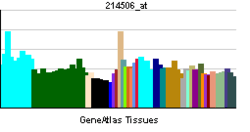GPR182
GPR182 (or G protein-coupled receptor 182) is a human gene (and associated protein) which is an orphan G-protein coupled receptor.[3]
When this gene was first cloned, it was proposed to encode an adrenomedullin receptor.[4] However, when the corresponding protein was expressed, it was found not to respond to adrenomedullin (ADM).[5]
It was subsequently shown that a different GPCR, CALCRL when complexed with RAMP2 can function as an ADM receptor.[6]
References
- ↑ "Human PubMed Reference:".
- ↑ "Mouse PubMed Reference:".
- ↑ Vassilatis DK, Hohmann JG, Zeng H, Li F, Ranchalis JE, Mortrud MT, Brown A, Rodriguez SS, Weller JR, Wright AC, Bergmann JE, Gaitanaris GA (April 2003). "The G protein-coupled receptor repertoires of human and mouse". Proc. Natl. Acad. Sci. U.S.A. 100 (8): 4903–4908. doi:10.1073/pnas.0230374100. PMC 153653
 . PMID 12679517.
. PMID 12679517. - ↑ Hänze J, Dittrich K, Dötsch J, Rascher W (November 1997). "Molecular cloning of a novel human receptor gene with homology to the rat adrenomedullin receptor and high expression in heart and immune system". Biochem. Biophys. Res. Commun. 240 (1): 183–188. doi:10.1006/bbrc.1997.7631. PMID 9367907.
- ↑ Kennedy SP, Sun D, Oleynek JJ, Hoth CF, Kong J, Hill RJ (March 1998). "Expression of the rat adrenomedullin receptor or a putative human adrenomedullin receptor does not correlate with adrenomedullin binding or functional response". Biochem. Biophys. Res. Commun. 244 (3): 832–837. doi:10.1006/bbrc.1998.8349. PMID 9535752.
- ↑ McLatchie LM, Fraser NJ, Main MJ, Wise A, Brown J, Thompson N, Solari R, Lee MG, Foord SM (May 1998). "RAMPs regulate the transport and ligand specificity of the calcitonin-receptor-like receptor". Nature. 393 (6683): 333–339. doi:10.1038/30666. PMID 9620797.
Further reading
- Lah JJ, Frishman WH (2002). "Adrenomedullin: a vasoactive and natriuretic peptide with therapeutic potential". Heart disease (Hagerstown, Md.). 2 (3): 259–65. PMID 11728267.
- Mukoyama M, Sugawara A, Nagae T, et al. (2002). "Role of adrenomedullin and its receptor system in renal pathophysiology". Peptides. 22 (11): 1925–1931. doi:10.1016/S0196-9781(01)00525-3. PMID 11754983.
- Fowler DE, Wang P (2002). "The cardiovascular response in sepsis: proposed mechanisms of the beneficial effect of adrenomedullin and its binding protein (review)". Int. J. Mol. Med. 9 (5): 443–9. doi:10.3892/ijmm.9.5.443. PMID 11956648.
- Kato J, Kitamura K, Kangawa K, Eto T (1995). "Receptors for adrenomedullin in human vascular endothelial cells". Eur. J. Pharmacol. 289 (2): 383–385. doi:10.1016/0922-4106(95)90117-5. PMID 7621913.
- Martínez A, Miller MJ, Catt KJ, Cuttitta F (1997). "Adrenomedullin receptor expression in human lung and in pulmonary tumors". J. Histochem. Cytochem. 45 (2): 159–64. doi:10.1177/002215549704500202. PMID 9016306.
- Hänze J, Dittrich K, Dötsch J, Rascher W (1997). "Molecular cloning of a novel human receptor gene with homology to the rat adrenomedullin receptor and high expression in heart and immune system". Biochem. Biophys. Res. Commun. 240 (1): 183–188. doi:10.1006/bbrc.1997.7631. PMID 9367907.
- Martínez A, Elsasser TH, Muro-Cacho C, et al. (1997). "Expression of adrenomedullin and its receptor in normal and malignant human skin: a potential pluripotent role in the integument". Endocrinology. 138 (12): 5597–5604. doi:10.1210/en.138.12.5597. PMID 9389548.
- Kennedy SP, Sun D, Oleynek JJ, et al. (1998). "Expression of the rat adrenomedullin receptor or a putative human adrenomedullin receptor does not correlate with adrenomedullin binding or functional response". Biochem. Biophys. Res. Commun. 244 (3): 832–837. doi:10.1006/bbrc.1998.8349. PMID 9535752.
- Jiménez N, Calvo A, Martínez A, et al. (1999). "Expression of adrenomedullin and proadrenomedullin N-terminal 20 peptide in human and rat prostate". J. Histochem. Cytochem. 47 (9): 1167–78. doi:10.1177/002215549904700909. PMID 10449538.
- Kuwasako K, Kitamura K, Ito K, et al. (2002). "The seven amino acids of human RAMP2 (86) and RAMP3 (59) are critical for agonist binding to human adrenomedullin receptors". J. Biol. Chem. 276 (52): 49459–49465. doi:10.1074/jbc.M108369200. PMID 11591721.
- Forneris M, Gottardo L, Albertin G, et al. (2002). "Expression and function of adrenomedullin and its receptors in Conn's adenoma cells". Int. J. Mol. Med. 8 (6): 675–9. doi:10.3892/ijmm.8.6.675. PMID 11712085.
- Hänze J, Groneberg DA, Rose F, et al. (2002). "Genomic organization and regulation of a human 7-helix transmembrane receptor which is expressed in pulmonary epithelial cells and induced in hypoxia". Biochem. Biophys. Res. Commun. 291 (5): 1160–1165. doi:10.1006/bbrc.2002.6595. PMID 11883938.
- Dumont CE, Muff R, Flühmann B, et al. (2003). "Paracrine/autocrine function of adrenomedullin in peripheral nerves of rats". Brain Res. 955 (1–2): 64–71. doi:10.1016/S0006-8993(02)03365-6. PMID 12419522.
- Strausberg RL, Feingold EA, Grouse LH, et al. (2003). "Generation and initial analysis of more than 15,000 full-length human and mouse cDNA sequences". Proc. Natl. Acad. Sci. U.S.A. 99 (26): 16899–16903. doi:10.1073/pnas.242603899. PMC 139241
 . PMID 12477932.
. PMID 12477932.
- Chosa E, Hamada H, Kitamura K, et al. (2003). "Expression of adrenomedullin and its receptor by chondrocyte phenotype cells". Biochem. Biophys. Res. Commun. 303 (1): 379–386. doi:10.1016/S0006-291X(03)00347-4. PMID 12646214.
- Xu P, Dai AG, Zhou HD, et al. (2004). "[Study of the expression and role of adrenomedullin and adrenomedullin receptor in patients with chronic obstructive pulmonary disease]". Zhonghua Jie He He Hu Xi Za Zhi. 26 (12): 765–8. PMID 14720432.
- Gerhard DS, Wagner L, Feingold EA, et al. (2004). "The status, quality, and expansion of the NIH full-length cDNA project: the Mammalian Gene Collection (MGC)". Genome Res. 14 (10B): 2121–2127. doi:10.1101/gr.2596504. PMC 528928
 . PMID 15489334.
. PMID 15489334.
External links
- "GPR182". IUPHAR GPCR Database. International Union of Pharmacology (IUPHAR). 2007-12-04. Retrieved 2008-07-03.

 . PMID 12679517.
. PMID 12679517. . PMID 12477932.
. PMID 12477932. . PMID 15489334.
. PMID 15489334.